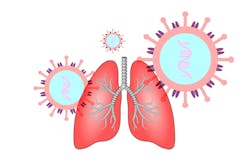Pathologists find evidence of pre-existing chronic lung disease in people with long COVID
Researchers at University of Michigan Health, part of Michigan Medicine, are examining lung biopsies from patients living with persistent respiratory symptoms, such as shortness of breath, to help better define the pattern of damage associated with COVID-19. Their work has led to a surprising finding: some patients’ symptoms could be due to damage that existed before getting COVID-19, according to a news release from the academic medical center.
Scientists have amassed evidence of a wide range of effects on the heart, lungs, brain and various other organs. Much of that insight has been gathered from autopsies of people who died from COVID-19. Yet, for the millions of people who survived the infection only to experience lingering symptoms, referred to colloquially as long COVID, much remains unknown.
The Department of Pathology team examined lung biopsies from 18 living patients who had ongoing respiratory symptoms or abnormal CT scans after recovering from COVID-19. Five patients were reported to have lung disease prior to their COVID-19 diagnosis. Fourteen patients had what is known as ground glass opacities on radiological scans, areas of the lungs that appear as a cloudy gray color as opposed to the dark color of normal air-filled lungs, on a chest X-ray or CT scan.
The most common finding in this set of patients was a condition known to pathologists as usual interstitial pneumonia, or UIP, also known clinically as idiopathic pulmonary fibrosis, or IPF, a well-studied chronic lung disease. IPF is the most common type of pulmonary fibrosis and causes scarring and stiffening of the lungs.
However, UIP/IPF is a progressive disease that gets worse with time and an infection, such as with SARS-CoV-2, can lead to accelerated illness or even death, what is known as an acute exacerbation of IPF, explained Myers. “SARS-CoV-2 comes along and does to the lung, from a pathology perspective, exactly what happens with an acute exacerbation.”
Biopsies from these patients show evidence of the underlying pre-existing lung scarring with, layered on top, evidence of diffuse alveolar damage, a pattern of lung tissue damage commonly seen in patients with acute respiratory distress syndrome of any cause.
